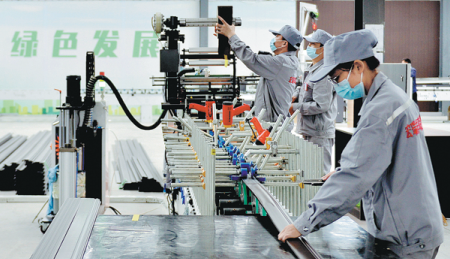Coal recycling measures yield promising results
Updated: 2021-12-24

New materials using recycled solid waste are produced at a plant in the county of Xiangyuan. [Photo by Wang Ruirui for China Daily]
The disposal of solid waste from the mining and production of coal has been a worldwide challenge. And this is especially true in the province of Shanxi, a major coal producer in China.
However, companies like Qiyuan Solid Waste Disposal, based in the city of Shuozhou in Shanxi, are trying to work out a solution.
At a construction site of the company, workers are busy building a plant that can recycle 5 million metric tons of coal ash per year.
According to Ju Yong, a manager in charge of the construction, more than 80 percent of the main structure has been completed and completion of the entire structure is expected next March.
Shuozhou has the largest volume of industrial solid waste in Asia, said Zhang Shouming, general manager of Qiyuan. "The city now has a stockpile of 100 million tons of coal ash and the volume is increasing by 3 million tons a year. This poses a severe challenge to the local environment."
Zhang said the new disposal and recycling plant under construction targets comprehensive utilization of coal ash.
"The project is designed to turn coal ash into various products, like silicon-aluminum-iron alloy, ceramics and bricks," Zhang said.
Shuozhou is one of the 12 demonstration cities in China for the comprehensive utilization of industrial solid waste and the Shuozhou Economic Development Zone is the city's major destination for the coal mine waste recycling industry.
The zone now has four dedicated industrial parks for the industry, with operations focusing on coal refuse-fired power generation, coal refuse comprehensive utilization, coal ash recycling and the production of plaster with coal ash as the raw material.
Backing the sector's development is the Shuozhou Solid Waste Recycling Research Center, jointly established by the city's government and Beijing-based Peking University.
Over the years, the center has developed a range of technologies and solutions with internationally advanced levels, helping the industry grow at a fast pace.
Sun Guofu, chief engineer at the center, said the industry in Shuozhou should focus on the coordination of high and low-end players for sustained development.
"In the solid waste recycling and utilization industry, the production of high-end products can yield higher profits but features a lower utilization rate of resources," Sun said. "And the lower-end production represents a reverse direction."
Sun suggests an industrial alliance be formed, allowing resources to be effectively used with both low and high-end players working together.
Shanxi's authorities hope Shuozhou's experience can be copied by the rest of Shanxi and offer the best solution to the mounting challenge of industrial solid waste.
Statistics show that Shanxi's stock of industrial solid waste was 1.4 billion tons at its peak, and there is a discharge of about 300 million tons of waste every year. This can lead to various environmental problems like pollution and threats to the ecosystem, local officials said.
In addition to Shuozhou, Shanxi has fostered the solid waste recycling industry in the cities of Jincheng and Changzhi.
Li Shu contributed to this story.



